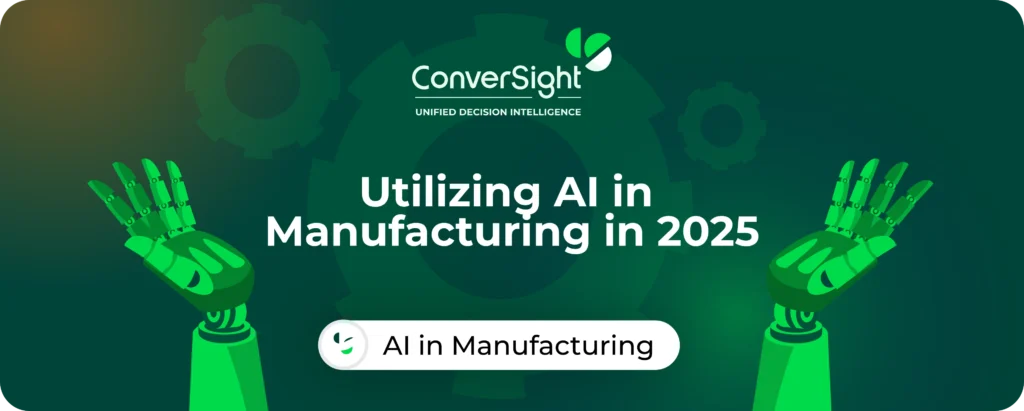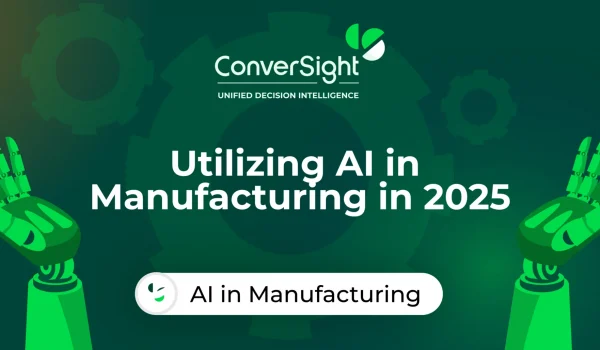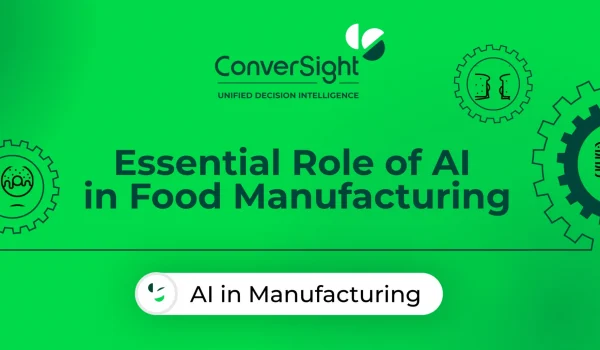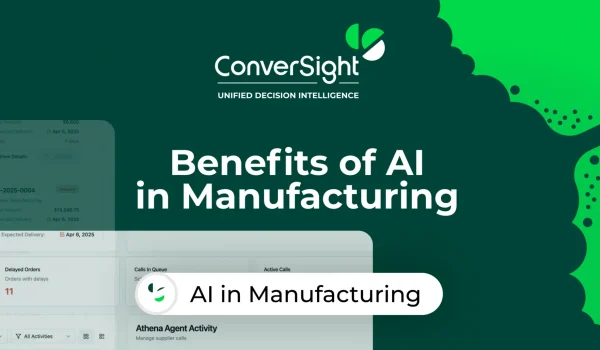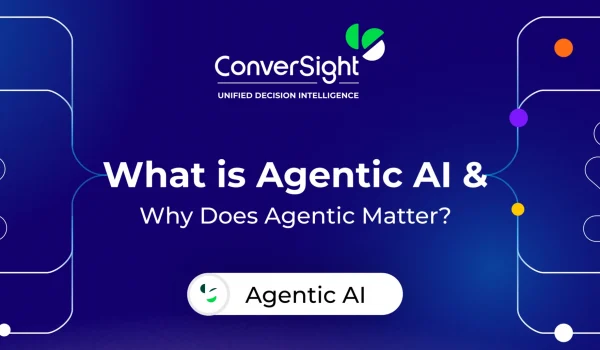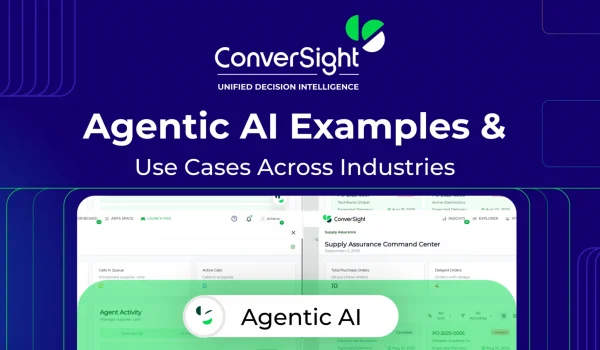How manufacturers are using AI to boost productivity, cut costs, and stay competitive
AI Is Transforming Manufacturing
Artificial Intelligence (AI) is transforming manufacturing at a pace once unimaginable. From factory floors to supply chain control towers, AI is driving the next industrial revolution — one defined by agility, precision, and intelligence. Gone are the days when automation alone could secure competitiveness. In today’s fast-moving markets, AI in manufacturing is not optional — it’s essential. It’s what enables companies to anticipate disruptions, optimize production, and adapt instantly to changing customer needs.
In this blog, we’ll explore real-world examples of AI in manufacturing across multiple industries from automotive and pharmaceuticals to food, semiconductors, chemicals, and textiles and see how leading organizations are turning data into efficiency, quality, and innovation.

AI in Manufacturing: Real-World Applications
Artificial Intelligence (AI) is revolutionizing how manufacturers design, produce, and deliver goods. It’s no longer just about automation or robotics, it’s about intelligence embedded at every stage of the manufacturing value chain. From predictive maintenance that prevents costly breakdowns to AI-powered analytics optimizing global supply chains, manufacturers are turning data into decisions faster than ever before.
Today’s AI-driven factories are self-learning ecosystems capable of sensing inefficiencies, anticipating disruptions, and adapting in real time. Here are some of the most transformative AI in manufacturing use cases being implemented across industries worldwide:
Here are some of the most impactful AI in manufacturing use cases seen across industries:
- Predictive Maintenance: Unplanned downtime can be costly. AI models analyze historical sensor data, equipment logs, and maintenance records to predict failures before they occur. By monitoring factors such as vibration, temperature, and power consumption, AI helps manufacturers reduce downtime and maintenance costs, extend equipment lifespan, and improve workforce scheduling and spare parts planning.
- Quality Assurance: AI-driven computer vision systems replace or augment manual inspections, detecting microscopic defects, misalignments, or color deviations that human eyes might miss. Unlike humans, AI operates continuously and delivers real-time, high-accuracy checks, improving consistency, reducing waste, and enhancing customer satisfaction.
- Demand Forecasting: AI predicts customer demand by analyzing market trends, seasonality, weather, and social sentiment. These insights help manufacturers align production schedules, allocate resources efficiently, and avoid stockouts or overproduction.
- Inventory & Supply Chain Optimization: AI provides end-to-end visibility across complex, global supply chains. Machine learning identifies bottlenecks, recommends optimal shipping routes, and suggests supplier alternatives. By automating procurement and predicting demand, AI ensures materials are available where and when needed without overstocking.
- Workforce Support: Rather than replacing jobs, AI empowers employees with real-time guidance and actionable insights. From digital assistants aiding troubleshooting to safety monitoring systems, AI enhances human expertise, turning every worker into a more informed decision-maker.
Boost efficiency and reduce downtime—see how ConverSight transforms manufacturing operations today. Learn More!
AI in Food Manufacturing
Challenges
Food manufacturers face some of the most demanding operational pressures in any industry. Key challenges include:
- Perishability: Many food products have short shelf lives, making timely production, distribution, and sales critical.
- Regulatory Compliance: Strict food safety standards (FDA, USDA, HACCP) require constant monitoring, documentation, and traceability.
- Waste Reduction: Overproduction or misaligned demand forecasts can result in significant food waste and financial loss.
Examples of AI in Action
- Detecting Food Contamination or Spoilage: AI-powered computer vision systems and sensor networks can detect subtle signs of spoilage or contamination before products leave the factory, reducing recalls and ensuring safety.
- Predicting Demand to Cut Waste: Machine learning models analyze historical sales, market trends, and seasonal patterns to forecast demand accurately, enabling production teams to reduce overproduction.
- Optimizing Recipes Based on Customer Preferences: AI can analyze customer data, nutritional requirements, and ingredient availability to suggest optimized recipes that improve taste, reduce costs, and meet changing consumer trends.
With AI, food manufacturers can achieve safer, more efficient, and more sustainable operations — producing high-quality food while minimizing waste.
Facing challenges in food and beverage production? Solve your operational problems with ConverSight. Learn More!
AI in Semiconductor Manufacturing
Challenges
Semiconductor production is a highly technical, precision-driven industry with extremely low tolerance for error. Key challenges include:
- Ultra-Precision Requirements: Manufacturing chips involves nanometer-scale precision, requiring meticulous control over every process step.
- Wafer Complexity: Each wafer contains hundreds or thousands of circuits; even minor defects can cause large-scale yield loss.
- Cost of Defects: High-value semiconductor products make even small errors expensive to fix.
Examples of AI in Action
- Defect Detection at Microscopic Scale: AI-powered imaging and computer vision systems can detect defects invisible to the human eye, ensuring higher product quality.
- Yield Optimization: Machine learning models analyze historical production and process data to maximize successful wafers per batch, reducing scrap and cost.
- Process Control with Predictive Analytics: AI monitors real-time machine and environmental data, automatically adjusting calibration to maintain precise production standards.
By applying AI, semiconductor manufacturers can improve yields, maintain ultra-precise quality standards, and reduce costly defects, boosting profitability and competitiveness.
AI in Automotive Manufacturing
Challenges
Automotive manufacturers operate in a highly dynamic environment. Major challenges include:
- Demand Volatility: Fluctuating market demand and customer preferences require flexible production planning.
- Need for Faster Production: Competitive pressure demands faster assembly and shorter time-to-market.
- Quality Standards: Automotive products must meet strict safety, reliability, and regulatory standards.
Examples of AI in Action
- Robotics for Assembly: AI-powered robots streamline assembly line operations, increasing speed, precision, and safety while freeing human workers for higher-value tasks.
- Predictive Maintenance for Machines & Vehicles: AI models monitor equipment and vehicle components to predict failures before they happen, reducing downtime and maintenance costs.
- Supply Chain Forecasting for Just-in-Time Delivery: AI analyzes market trends, production schedules, and logistics data to optimize parts inventory and delivery timing, reducing excess stock and improving responsiveness.
AI in Textile & Apparel Manufacturing
The textile and apparel industry operates at the speed of fashion — trends shift overnight, and manufacturers must balance creativity, quality, and sustainability while navigating complex global supply chains.
Key Challenges
- Fast-Changing Consumer Demand: Rapid trend cycles and unpredictable market shifts make it difficult to forecast accurately.
- Quality Consistency: Ensuring defect-free fabrics and garments at scale is still a persistent challenge.
- Sustainability Pressure: Consumers increasingly demand eco-friendly materials and ethical production practices.
- Inefficient Global Supply Chains: Fragmented suppliers and logistics networks often cause delays, waste, and overproduction.
Examples of AI in Action
- AI-Driven Fabric Defect Detection: Using computer vision, AI can identify imperfections in fabric textures and patterns in real time, ensuring only flawless materials move forward in production.
- Predicting Fashion Demand: Machine learning models analyze sales data, social media trends, and market signals to anticipate changing consumer preferences — allowing brands to align production with demand.
- Smart Sewing and Robotic Garment Production: AI-powered robots and automation tools streamline repetitive sewing and assembly tasks, boosting productivity and precision.
- Inventory Optimization Across Global Supply Chains: AI systems provide real-time insights into material flows, inventory levels, and supplier performance, reducing overstocking and improving responsiveness.
- AI for Sustainable Material Sourcing: AI helps manufacturers identify sustainable suppliers and optimize material selection based on environmental and ethical factors.
By integrating AI, textile and apparel manufacturers can create more agile, efficient, and sustainable operations — staying ahead of trends while minimizing waste and maximizing profit.
AI in Chemical Manufacturing
Chemical manufacturing plays a vital role in industries ranging from pharmaceuticals to energy, but it also faces complex operational, environmental, and safety challenges.
Key Challenges
- High Energy Consumption: Many chemical processes are energy-intensive, driving up costs and carbon emissions.
- Strict Safety and Environmental Regulations: Compliance and worker safety are paramount, with little room for error.
- Hazard Risks: Handling volatile substances requires constant vigilance and precision.
- Demand for Sustainable Formulations: There’s growing pressure to innovate with greener, more efficient chemical products.
Examples of AI in Action
- Process Optimization: AI models analyze chemical reactions in real time to adjust conditions such as temperature and pressure, improving yield and reducing waste.
- Hazard Detection and Worker Safety: Computer vision and sensor-based AI systems detect leaks, spills, or unsafe conditions instantly, helping prevent accidents.
- Predictive Analytics for Equipment Reliability: By monitoring vibration, heat, and other performance metrics, AI predicts equipment failures before they occur, avoiding costly downtime.
- Reducing Energy Consumption: AI optimizes energy use in large-scale plants by fine-tuning equipment operation schedules and identifying inefficiencies.
- Compliance Monitoring: AI automates reporting and ensures adherence to environmental and safety standards, reducing manual work and minimizing the risk of violations.
Through AI, chemical manufacturers are achieving safer, more efficient, and more sustainable production — advancing both innovation and responsibility.
The Future of AI in Manufacturing
From textiles to semiconductors, food production to automotive assembly, AI is transforming how manufacturers operate. These technologies are helping industries unlock new levels of precision, agility, and sustainability — redefining what’s possible on the factory floor.
The future belongs to smart, autonomous, and sustainable factories, powered by real-time insights and adaptive intelligence. As AI continues to evolve, manufacturers that embrace it today will lead tomorrow — delivering higher quality, greater efficiency, and a smaller environmental footprint.
At ConverSight, we help manufacturers harness the full power of AI with real-time, conversational insights that bring clarity to complex operations. Whether optimizing production, improving supply chain visibility, or driving innovation, our AI-powered platform helps you make smarter, faster, and more confident decisions.
Ready to unlock the future of AI in manufacturing? Start your journey with ConverSight today. Book a Demo!
